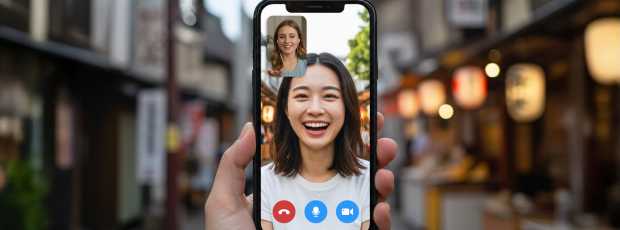We had a fantastic full-day tour with Nobu. He planned out a thoughtful itinerary for us, taking into account our interests. He was particularly knowledgeable about culture and history. We couldn't have had a better experience in Tokyo. Recommend 100%!Cheng-Han, Tokyo, 2025
Table Of Contents
- A Season That Whispers
- When Do Sakura Trees Bloom in Tokyo?
- What Full Bloom Feels Like
- Late March vs. Early April: What's the Difference?
- Hanami Parties and Sakura Festivals
- Where to See Cherry Blossoms in Tokyo
- The Role of Weather in the Sakura Season
- Is March or April Better for Cherry Blossom Viewing?
- Nighttime Blossoms: A Different Magic
- Planning Tips for First-Time Sakura Visitors
- What to Expect Beyond the Blossoms
- Pairing It with Kyoto? Read This First
- Final Thoughts: Chasing Petals, Catching Moments

Cherry Blossom trees along Meguro River. Image by Sora Sagano from Unsplash
A Season That Whispers
There's a moment each year when Tokyo exhales winter and breathes in something entirely different. I've witnessed this transformation forty-three times now, and still it catches me unprepared – the way morning light suddenly carries the promise of sakura, the way the city's concrete pulse softens into something more tender.
That electric anticipation that runs through Tokyo's veins when cherry blossom season approaches.

Ueno Park Cherry blossoms. Image by Trevor Paxton from Unsplash
The cherry blossoms don't announce themselves with fanfare.
They arrive like a whispered secret, first as tight green buds, then as the faintest blush of pink. My grandmother said Sakura teach us about timing, not the cold precision of timetables, but the natural flow of the changing seasons.
In Tokyo, we don't just see cherry blossoms; we feel them.
They infiltrate our daily routines, change our familiar streets, and remind us that even in this city of fourteen million souls, nature still holds the power to stop us in our tracks.
The question visitors always ask me is simple: when is the best time to come? The answer, like the blossoms themselves, it's more nuanced than it appears.
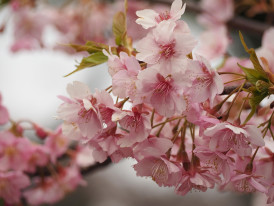
Close-up of cherry blossoms. Image by ftanuki from Pixabay
The Japan Meteorological Agency has been tracking cherry blossom forecasts since 1955, and their predictions have become as anticipated as the blossoms themselves.
In Tokyo, sakura trees typically begin their bloom between late March and early April, with full bloom usually occurring seven to ten days after the first blossoms appear.
Dates shift like morning mist – influenced by winter temperatures, spring rainfall, and the mysterious inner clock that each cherry tree keeps.
See Tokyo in Full Bloom Your Way
Book a local experience shaped around you, not a schedule. No scripts, no groups. Just the city, at its most unforgettable.

Cherry blossoms first signs of blooming. Image by Line Knipst from Pexels
When Do Sakura Trees Bloom in Tokyo?
I’ve learned to read the city’s subtle signs. The photographers who begin gathering in Ueno Park two weeks before predicted bloom.
The way office workers start taking different routes home, unconsciously gravitating toward tree-lined streets.
The appearance of hanami party supplies in department stores, stacked like promises of celebration to come.
The bloom period in Tokyo is remarkably brief – typically lasting only one to two short weeks. This ephemeral nature is precisely what makes sakura season so precious.
Unlike autumn leaves that linger for months, cherry blossoms demand your presence. They won’t wait for convenient schedules or perfect weather.
Understanding bloom timing means accepting uncertainty as part of the experience. I’ve seen years when warm March weather accelerated blooming, and others when late cold snaps delayed the first blossoms until mid-April.
The cherry blossom season teaches patience and flexibility – qualities that serve travelers well.
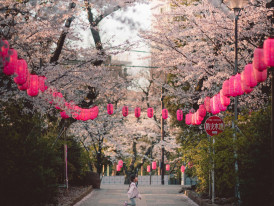
Lanterns along the cherry blossoms. Image by Ryan Millier from Pexels
What Full Bloom Feels Like
Mankai (full bloom) isn’t just a botanical term in Tokyo; it’s a state of being.
When cherry blossom trees reach full bloom, the city turns into something that exists nowhere else on earth.
I walked through Nakameguro last April during peak mankai, and the experience defied every attempt at description.
The canal that runs through Nakameguro becomes a river of light during cherry blossom season. Trees arch overhead, their branches heavy with blossoms, creating natural tunnels of pink and white.
The air itself seems to shimmer with falling petals, each one catching the light like tiny dancers performing their final act.
During this time, people flock to the most popular viewing spots, drawn by the spectacle and the promise of witnessing the fleeting beauty of sakura at its peak.
Full bloom brings a sensory intensity that photographs can’t capture.
There’s the visual saturation, every direction filled with blossoms so dense they seem to pulse with their own light.
The gentle sound of petals rustling in spring breezes, mixed with the excited murmur of visitors speaking in dozens of languages, cherry blossom trees whisper sweet-nothings in the wind. The sweet, faint fragrance that cherry blossoms carry, barely perceptible but unmistakably present.
During mankai, time moves differently. I watched a businessman stop mid-stride on his way to catch a train, pulled by some magnetic force to stand beneath a particularly magnificent tree.
He stood there for three full minutes, briefcase forgotten, just breathing in the moment. This is what full bloom does to Tokyo, it makes philosophers of salary workers and poets of pragmatists.

Hand reaching towards Cherry Blossoms. Image by Ryunosuke Kikuno from Unsplash
The peak typically lasts three to five days, depending on weather conditions. During these precious days, the trees are so laden with blossoms that branches droop under their weight. This is when photographers achieve their dream shots, when hanami parties reach their most joyful, and Tokyo shows its most tender heart.
Early April delivers the spectacle most visitors dream of seeing.
Plan Your Perfect Sakura Stroll
City Unscripted helps you plan a blossom-filled trip that’s personal, not packaged. Friendly experience, no fluff, just what matters to you.

Night park event: Photo by Muhammad Faiz Zulkeflee on Unsplash
Late March vs. Early April: What's the Difference?
The timing of your visit in cherry blossom season dramatically shapes your experience. I’ve guided visitors during both late March and early April, and each period offers distinct advantages and challenges.
Late March brings anticipation and discovery.
The first blossoms appear like shy performers testing the stage before the main show. You’ll find fewer crowds, especially on weekdays, and a sense of shared excitement among those who’ve come early.
The weather can be unpredictable – some days still carry winter’s chill, requiring layers and patience.
Early April delivers the spectacle most visitors dream of seeing.
By the first week of April, most sakura trees in Tokyo reach full bloom simultaneously, creating that breathtaking carpet of pink that appears in every postcard.
The warmer weather encourages longer outdoor viewing sessions and more comfortable hanami parties.
However, early April also brings peak season crowds. Popular viewing spots like Ueno Park and Shinjuku Gyoen can feel overwhelmed, especially on weekends.
If you prefer a more peaceful experience, steer clear of weekends when crowds are at their heaviest.
The very intensity that makes early April magical also makes it demanding. You’ll share your cherry blossom moments with thousands of others who’ve made the same pilgrimage.

Empty park with Cherry Blossoms: Photo by Yeonghun Song on Unsplash
I often recommend a middle path, arriving in the final days of March with flexibility to extend your stay into early April. This approach allows you to experience both the anticipation and the climax of sakura season. This time of the year offers peak petals but thicker crowds.

Picnic under the Cherry Blossomes: Photo by Arthur Tseng on Unsplash
Hanami Parties and Sakura Festivals
Hanami (literally “flower viewing”) turns Tokyo’s parks into outdoor dining rooms during cherry blossom season.
These gatherings represent one of Japan’s most cherished traditions, where colleagues, friends, and families claim spots under blooming trees for hours-long celebrations.
Hanami is also a highlight of Japan’s rich tradition of cultural festivals during spring, drawing locals and visitors alike to celebrate the season’s beauty.
The etiquette of hanami reflects Japanese social harmony. Groups arrive early to secure prime positions, spreading blue tarps that become temporary territories.
Someone always volunteers to guard the space while others gather food and drinks. By afternoon, these individual islands of celebration merge into a continuous festival atmosphere.
Tokyo’s major parks host official cherry blossom festivals that amplify the hanami experience.
Ueno Park’s festival, running from mid-March through early May, features temporary food stalls serving everything from yakitori to cherry blossom-flavored soft ice cream.
The festival atmosphere peaks during full bloom, when vendors stay open late into the evening to accommodate night viewing crowds.
Shinjuku Gyoen offers a more controlled hanami experience.
While alcohol isn’t permitted, the manicured gardens provide stunning backdrops for more contemplative flower viewing.
The annual cherry blossom festival here focuses on the diversity of sakura varieties, with over sixty different types blooming at slightly different times.
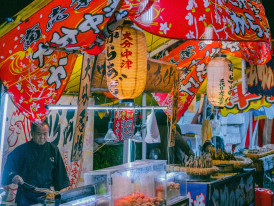
Temporary food stalls: Photo by Jenny Mavimiro: Pexels
For a truly memorable hanami experience, arrive prepared with a picnic blanket, patience for crowds, and respect for the spaces others have claimed.
The communal spirit of hanami parties creates some of Tokyo’s most memorable moments – strangers sharing food, children running between family groups, and the gradual transition from afternoon picnics to evening celebrations under illuminated blossoms.
Cherry blossom crowds? No problem.
A local host can help you time it right and steer you to peaceful spots even in peak season.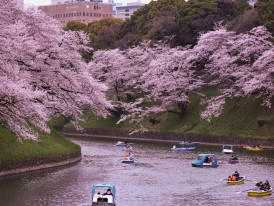
Rowboats on the river Photo by KESHAB BASNET: Pexels
Where to See Cherry Blossoms in Tokyo
Ueno Park is Tokyo’s most celebrated hanami destination, home to over 1,000 cherry trees and the city’s largest outdoor hanami parties.
The park’s central position and train station access make it convenient, but expect significant crowds during peak bloom.
Early morning visits gives you a look at Ueno’s quieter beauty, when mist rises from ponds and the first photographers capture empty pathways lined with blossoms.
Chidorigafuchi offers Tokyo’s most romantic sakura experience.
The moat beside the Imperial Palace creates perfect reflections of overhanging cherry trees, while rental rowboats allow visitors to float directly beneath the blooms.
Night illumination transforms Chidorigafuchi into something from a dream, with lit blossoms creating pink tunnels over dark water.
Shinjuku Gyoen is Tokyo’s botanical showcase for cherry blossoms, featuring both native Japanese varieties and international cultivars.
The park’s entrance fee keeps crowds slightly smaller, and the spacious grounds accommodate more peaceful viewing.
The greenhouse adds year-round appeal for visitors who arrive outside bloom season.
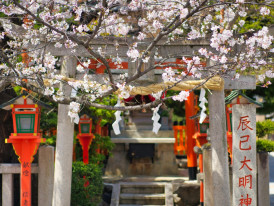
Shrine Among Cherry Blossoms: Photo by Frank Lee: Pexels
Beyond famous locations, Tokyo’s neighborhood shrines offer intimate sakura encounters.
The approach to Nezu Shrine becomes a tunnel of pink during peak bloom, while small local temples throughout the city feature ancient cherry trees that have witnessed decades of spring celebrations.
These hidden sightseeing spots reward curious visitors who venture beyond tourist maps.

Sakuras in the rain: Image by MYCCF from Pixabay
The Role of Weather in the Sakura Season
Weather shapes every aspect of Tokyo’s cherry blossom season, from initial bloom timing to the duration of peak viewing. Temperature fluctuations can dramatically accelerate or delay blooming.
A string of warm days in late February might push first buds ahead of schedule, while unexpected cold snaps can pause development for weeks.
Once the right conditions are met, the trees burst into bloom, transforming from bare branches to full blossom in mere days.
Rain presents both challenges and opportunities during sakura season.
Heavy storms can strip trees of their blossoms in hours, ending peak viewing periods abruptly. However, light spring rains create some of the most photogenic moments – water droplets clinging to petals, the enhanced fragrance of wet blossoms, and the way colors intensify under cloudy skies.
Wind patterns affect the famous “petal snow” that characterizes the end of bloom periods.
Gentle breezes create the romantic cascade of falling petals that appears in countless photographs, while stronger winds can strip trees bare prematurely.
I’ve learned to appreciate both calm days that preserve the blooms and breezy afternoons that fill the air with dancing petals.
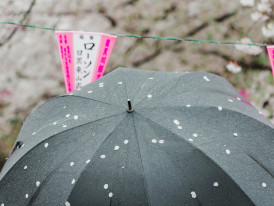
Cherry blossoms falling onto an Umbrella: Photo by Ryoji Iwata on Unsplash
Tokyo’s urban heat island effect creates micro-climates that influence blooming patterns throughout the city. Trees in warmer central districts often bloom several days before those in suburban areas, allowing viewers to follow the wave of blooming across different neighborhoods.
Is March or April Better for Cherry Blossom Viewing?
This question reaches the heart of what draws visitors to Tokyo during sakura season.
Both months offer distinct experiences, and the “better” choice depends on your priorities and tolerance for uncertainty.
March appeals to visitors who prefer discovery over spectacle.
You might witness the magical moment when tight buds turn into first blossoms, or find yourself among the first to photograph a particularly spectacular tree.
March weather requires preparation – some days feel like winter’s last stand, while others hint at spring’s arrival.
The uncertainty of March timing adds adventure to the experience. I’ve guided visitors who arrived to find bare trees, only to witness the miraculous transformation as buds opened during their stay.
These travelers often describe feeling personally connected to the blooming process, as if they’d been present for something few others had witnessed.
April delivers the iconic cherry blossom experience that fills social media feeds and travel magazines.
By early April, most of Tokyo’s sakura trees reach simultaneous peak bloom, creating that overwhelming abundance of pink that defines the season.
Many international travelers plan their trips to coincide with the last week of March or the first week of April, aiming to catch the peak bloom at its best.
Weather typically warms enough for comfortable outdoor viewing, and longer daylight hours extend photography opportunities.
Experience Tokyo’s After-Hours Magic
Pair daytime petals with a night led by a local. We'll plan something flexible, personal, and anything but a typical tour.
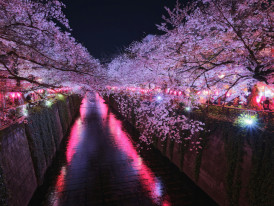
Cherry blossoms at night time: Photo by Takashi Miyazaki on Unsplash
Nighttime Blossoms: A Different Magic
Yozakura (night time cherry blossom viewing) shows a completely different face of Tokyo's sakura season.
As darkness falls, strategically placed lights turn blooming trees into glowing sculptures that seem to float in the night air.
Sumida Park offers Tokyo's most dramatic yozakura experience.
The trees lining both sides of the Sumida River are illuminated from dusk until 10 PM during peak bloom, creating reflections that double the visual impact.
Walking across the bridges that span the river provides elevated viewpoints where the entire illuminated cherry blossom corridor spreads below.
The atmosphere during yozakura differs markedly from daytime viewing.
Crowds thin as families with children return home, leaving the illuminated blossoms to couples, photographers, and contemplative individuals.
The city's background hum softens, allowing subtle sounds to be heard, the rustle of leaves, distant conversations, and the gentle splash of river water.
Roppongi's Tokyo Midtown complex creates a more urban yozakura experience, where modern architecture frames illuminated cherry trees.
The contrast between contemporary buildings and ancient sakura traditions creates uniquely Tokyo moments that capture the city's ability to blend old and new.

People walking along the lantern lit path: Photo by DRAPE Rasidi: Pexels
More than 26,223 5-star reviews and counting
26,223+ 5-Star Reviews and Counting
Trusted and recommended by travelers worldwide.
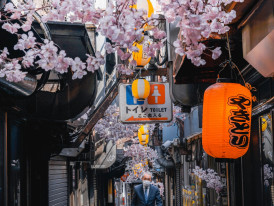
Quiet alley lined with Cherry Blossoms: Photo by Anh Nguyen: Pexels
Planning Tips for First-Time Sakura Visitors
Successful cherry blossom viewing in Tokyo requires balancing careful planning with flexibility for nature’s unpredictable timing.
Many travelers choose to visit Japan specifically during cherry blossom season for this unforgettable experience, so it’s important to consider the best time to visit Japan to catch the sakura in full bloom.
I’ve learned that the most satisfied visitors come prepared for various scenarios while being open to unexpected discoveries.
Monitor the Japan Meteorological Agency’s cherry blossom forecasts, which update regularly as the season approaches.
These predictions become increasingly accurate within two weeks of projected blooming, but earlier forecasts should be viewed as general guidance.
Build flexibility into your travel schedule if possible. The difference between arriving three days early versus three days late can mean experiencing bare trees versus peak bloom.
Consider booking refundable accommodations or maintaining flexibility in your itinerary to extend or shift your visit based on real-time bloom conditions.
Avoid weekends during peak bloom if you prefer less crowded viewing experiences.
Domestic travelers create the heaviest crowds on Saturdays and Sundays, when popular locations can become overwhelmingly busy.
Weekday mornings offer the most peaceful viewing opportunities, especially at famous sites that become party zones by afternoon.
[IMAGE: Quiet side alley lined with trees.]
Pack for variable weather conditions. Tokyo’s spring weather can shift from winter-like cold to summer warmth within the same week.
Layered clothing, comfortable walking shoes, and a compact umbrella prepare you for the full range of conditions you might encounter during extended outdoor viewing sessions.
When planning your trip, remember that the optimal time to visit Japan for cherry blossoms can vary each year due to weather.
Planning your time to visit Japan carefully will help ensure you experience the cherry blossoms at their best.
See a Side of Tokyo That’s Just for You
Go beyond the blossoms with flexible, one-of-a-kind experiences led by locals who know Tokyo in full color.

Woman in Yukuta near cherry blossoms: Photo by Eugenio Felix: Pexels
What to Expect Beyond the Blossoms
Cherry blossom season in Tokyo offers experiences that extend far beyond flower viewing. The cultural rituals, seasonal foods, and subtle changes in city life create a comprehensive spring experience for observant visitors.
The ephemeral beauty of the cherry blossom flowers inspires not only visual enjoyment but also seasonal foods, traditions, and a renewed sense of community throughout the city.
Seasonal menu changes appear throughout Tokyo during sakura season.
Restaurants introduce cherry blossom-flavored items ranging from delicate wagashi sweets to sakura beer and even cherry blossom salt for seasoning.
Department store basement food courts show off elaborate seasonal displays, turning everyday shopping into cultural exploration.
Traditional clothing experiences increase during cherry blossom season.
Kimono and yukata rental shops report peak business as both Japanese and international visitors dress in traditional garments for hanami parties and photography sessions.
The visual harmony between traditional clothing and blooming sakura creates some of the season’s most memorable imagery.

Traditional outdoor hot spring near Tokyo. Photo by Tayawee Supan on Unsplash
The seasonal transition affects Tokyo’s entire vibe. Office workers linger longer during lunch breaks, drawn to nearby parks and tree-lined streets.
Evening commutes become more pleasant as longer daylight hours illuminate the blooming city. This subtle shift in urban energy becomes part of the cherry blossom experience for sensitive observers.
Explore more of Tokyo with our curated Tokyo experiences to discover how the city’s character changes throughout the seasons.

Cherry blossoms in Kyoto: Photo by Marek Piwnicki: Pexels
Pairing It with Kyoto? Read This First
Many visitors consider combining Tokyo’s cherry blossom season with Kyoto’s equally spectacular spring display.
This approach can create a comprehensive sakura experience, but timing differences between the two cities require careful consideration.
Kyoto’s cherry blossoms typically bloom three to seven days later than Tokyo’s, creating opportunities to follow the blooming wave across Japan.
However, this timing difference varies yearly based on weather patterns, and both cities can occasionally bloom simultaneously, creating logistical challenges for visitors trying to experience both at peak bloom.
Some of Kyoto's most iconic cherry blossom viewing spots include Philosopher's Path, Maruyama Park, and the Kamo River.
The cultural contexts differ significantly between Tokyo and Kyoto’s cherry blossom seasons. Tokyo’s modern urban setting creates dynamic contrasts between contemporary life and traditional beauty, while Kyoto’s historical temples and traditional neighborhoods provide more classical sakura experiences.
Visitors who experience both cities often find the contrast enhances appreciation for each location’s unique character.
Transportation between Tokyo and Kyoto is efficient during cherry blossom season, though advance reservations become essential for shinkansen tickets during peak bloom periods.
The three-hour journey allows morning departure from one city with afternoon arrival in the other, maximizing viewing opportunities across both destinations.
If you’re planning a wider spring journey, here’s the best time to visit Tokyo and Kyoto for comprehensive guidance on optimizing your sakura experience across both cities.

Cherry blossoms on Empty Park Bench: Photo by VIrginia Lam on Unsplash
Final Thoughts: Chasing Petals, Catching Moments
After four decades of Tokyo cherry blossom seasons, I’ve learned that the question “when is the best time?” misses the deeper truth about sakura.
Japan's cherry blossom season is celebrated nationwide, with each region offering its own best examples of sakura viewing, from iconic parks to hidden temples.
The best time isn’t written in meteorological forecasts or marked on calendars – it’s created by the intersection of blooming trees and human presence, natural beauty and personal readiness to receive it.
Many of Japan’s cherry blossom traditions trace their roots back to the Edo period, when hanami became a cherished cultural event.
I think of cherry blossoms as Tokyo’s annual reminder about mono no aware – the poignant awareness of impermanence that runs through Japanese aesthetics.
The brief blooming period, the inevitable fall of petals, the gradual return to green leaves – all of this speaks to life’s precious, temporary nature.
The visitors who find the most meaning in Tokyo’s cherry blossom season aren’t necessarily those who arrive during perfect peak bloom conditions.
They’re the ones who stay present to whatever the trees offer – first buds that hint at coming beauty, full bloom that overwhelms the senses, or even the gentle rain of falling petals that signals the season’s end.
Some travelers enjoy heading deeper into less-visited areas or national parks, such as those in the Japanese Alps, for a more intimate experience away from the crowds.
Japan’s cherry blossom experiences are remarkably diverse: from early February festivals like the Kawazu Cherry Blossom Festival, to early March blooms in the southern regions, to late blooms in the northern parts such as Hokkaido, where the season can last until mid May.
While Tokyo is on mainland Japan, the sakura front moves northward, and cherry blossom-related events and transitions occur throughout the year, from mid February to mid September and even into mid July in some regions.
Viewing can be enjoyed even during the rainy season or Golden Week, though timing and crowds vary, and careful planning is needed to make the most of these periods.
This morning, as I finish writing this guide, I notice the first signs of spring’s approach.
Not in any particular tree or specific forecast, but in the quality of light, the angle of shadows, the subtle shift in how the city breathes.
Soon, Tokyo will transform once again into a place where petals dance in the air and strangers share moments of wonder beneath blooming trees.
The best time to see cherry blossoms in Tokyo is when your heart is ready to receive their brief, perfect gift.
Everything else – timing, weather, crowds – becomes part of the story you’ll carry long after the last petal falls.
One Season. One Local. One Experience Just for You.
SEE TOKYO EXPERIENCESSee Sakura Season Through a Local’s Eyes
City Unscripted pairs you with a local host who plans a private Tokyo experience shaped around your style, not a standard route.
Speak to a Tokyo Local, Not a Travel Rep
Chat with someone who knows the city, and the season, inside out. No pressure, just friendly advice to help you plan a trip that fits you.









